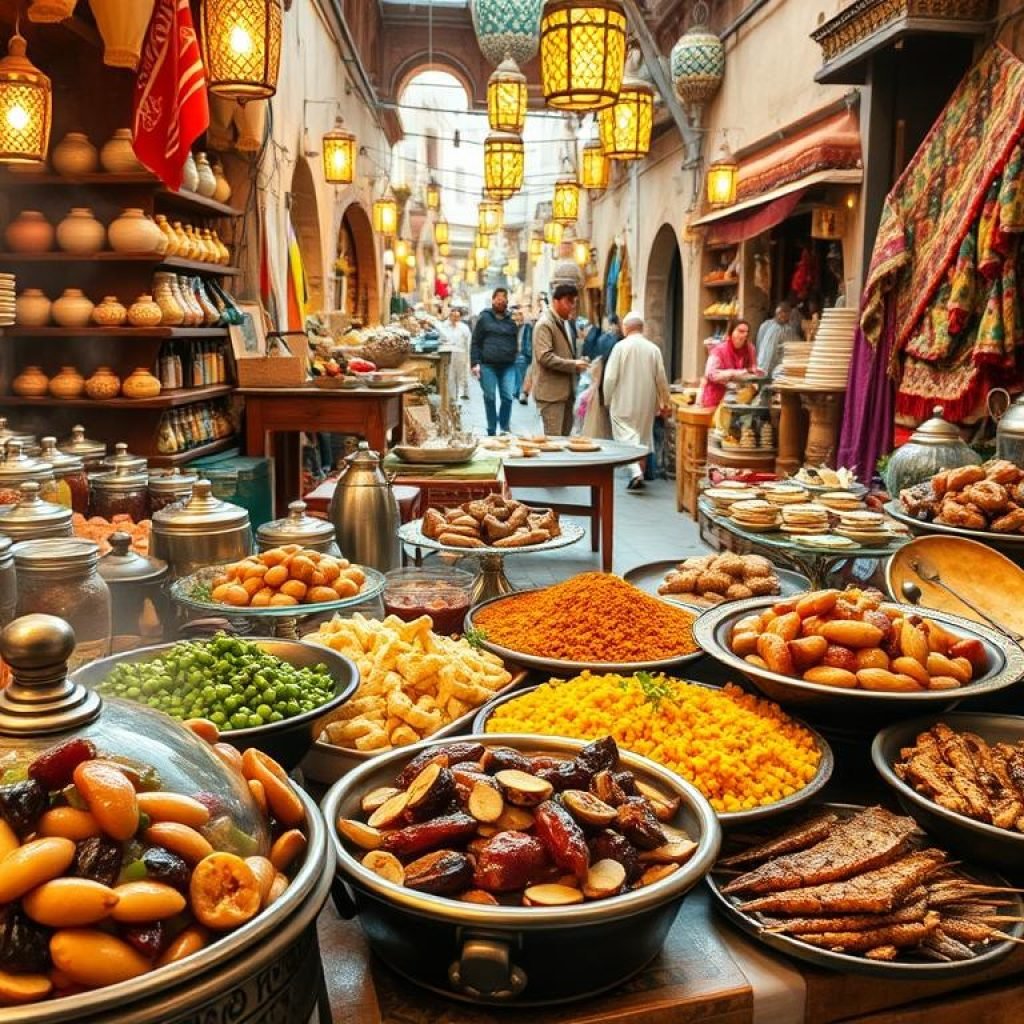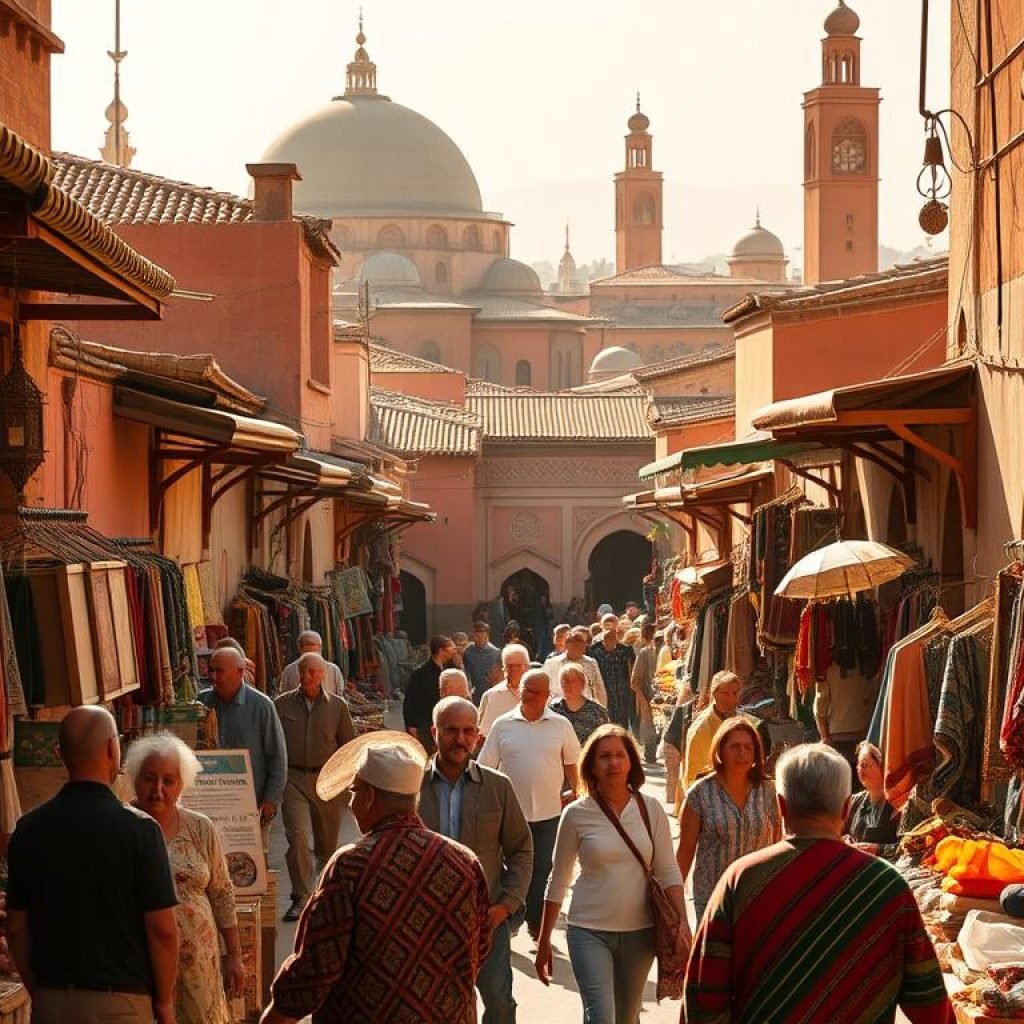Imagine diving into a world where Arab, Berber, and Mediterranean cultures meet. Morocco is a perfect spot for those wanting a real cultural adventure. Here, you can explore a rich history, diverse landscapes, and meet friendly locals. You’ll get to see how Moroccan culture works, learn about its society, and understand the role of women.
From Marrakech’s lively streets to the Atlas Mountains’ calm beauty, Morocco offers a memorable cultural journey. You’ll see how Moroccan culture is unique and how women play a big part in it. This trip will give you memories that last a lifetime.
To really get Moroccan culture on a short trip, you need to know the local ways. By doing this, you can dive into the culture, meet the locals, and make memories that will stay with you. So, what makes Moroccan culture special, and how can you experience it in a short time?
Key Takeaways
- Experience Moroccan culture by immersing yourself in the local customs and traditions
- Understand the significance of Moroccan society and its diverse influences
- Learn about the important role of women in Moroccan society
- Explore the vibrant cities, diverse landscapes, and rich history of Morocco
- Discover the unique blend of Arab, Berber, and Mediterranean influences that shape Moroccan culture
- Engage with the friendly people and create unforgettable memories
- Immerse yourself in the local culture to truly experience Moroccan culture on a short trip
Introduction to Moroccan Culture
Moroccan culture is a mix of many influences. It values hospitality, respect, and tradition highly. The country’s history, geography, and diverse ethnic and religious groups shape its culture. Gender roles in Morocco are also a big part of it, with both old traditions and new changes affecting men and women.
There’s been a push for women’s rights in North Africa, including Morocco. This has opened doors for women in education, work, and politics. Yet, old customs still influence Moroccan culture and people’s lives.
Moroccan culture is known for its lively arts, tasty food, and traditional music and dance. The country hosts many festivals, like the Marrakech International Film Festival and the Fez Festival of World Sacred Music. These events highlight the culture’s diversity and richness, offering a glimpse into Morocco’s history and traditions.
Exploring Moroccan Cuisine
Moroccan cuisine is a mix of flavors that show the country’s rich culture. You’ll find dishes like tagines, couscous, and pastilla. The spice blend, ras el hanout, is key in Moroccan stews, highlighting the country’s culinary history.
In Morocco, women’s empowerment in the Maghreb is linked to keeping traditional cooking alive. Female leadership in Morocco shines in the kitchen, where women share recipes and techniques across generations.
Some must-try Moroccan dishes are:
- Tagine: a slow-cooked stew with meat, veggies, and dried fruits
- Couscous: a dish from rolled and steamed semolina flour
- Pastilla: a savory pie with flaky pastry, meat, and spices

For a real taste of Morocco, check out the street food. Try grilled chicken skewers, fried sardines, and cumin-dusted chickpeas. Jemaa el-Fnaa in Marrakesh is a top spot for local street food.
| Dish | Ingredients | Description |
|---|---|---|
| Tagine | Meat, vegetables, dried fruits | A slow-cooked stew with a spice blend |
| Couscous | Semolina flour, water, salt | A dish made from rolled and steamed semolina flour |
| Pastilla | Flaky pastry, meat, spices | A savory pie with flaky pastry, meat, and spices |
Discovering Moroccan Architecture
Moroccan architecture is a mix of Arab, Berber, and Mediterranean styles. It focuses on detailed designs, ornate decorations, and lovely gardens. The country’s rich culture is seen in its buildings, shaped by history and different styles.
The role of women in Moroccan society has shaped the architecture. Traditional norms have led to buildings with separate areas for men and women. But, modern architecture is moving towards more inclusive designs, showing the country’s changing values.
Places like the Hassan II Mosque in Casablanca and the El Bahia Palace in Marrakesh are famous. They show Morocco’s cultural heritage and unique architectural mix. Moroccan architecture is not just beautiful; it also tells the country’s story.
Key features of Moroccan architecture include:
- Intricate designs and ornate decorations
- Beautiful gardens and courtyards
- Use of traditional materials such as earth, wood, and stone
- Incorporation of Islamic and Arab influences
- Blend of traditional and modern styles
Moroccan architecture is a unique and captivating part of the country’s culture. Its history, stunning designs, and mix of old and new make it a top spot for architecture, history, and culture lovers.
Engaging with Local Traditions
Moroccan traditions are full of life and color, showing off the country’s rich culture. Music, dance, and crafts are at the heart of these traditions. To really get to know Moroccan culture, you need to dive into local customs.
Women are key in keeping Moroccan traditions alive. They play a big part in women’s rights in North Africa and Moroccan feminism. By supporting local crafts and going to cultural events, you help empower women in Morocco.
Some big festivals in Morocco include the Gnawa World Music Festival in Essaouira and the Fes Festival of World Sacred Music. These festivals highlight Morocco’s deep musical roots. They offer a chance for people from different cultures to come together.
Traditional crafts like pottery, leatherwork, and textiles are a big part of Morocco’s identity. You can find these crafts in the lively souks and markets. There, you can also support local artists.
| Moroccan Festival | Description |
|---|---|
| Gnawa World Music Festival | A celebration of Moroccan music and culture |
| Fes Festival of World Sacred Music | A showcase of sacred music from around the world |
Language and Communication in Morocco
Traveling to Morocco can be more enjoyable if you know the local language and customs. The Moroccan language combines Arab, Berber, and French, focusing on hospitality and respect. About 33% of Moroccans speak French, 5-10% Spanish, mainly in the north. Around 14% know some English, especially among the young.
Women in Morocco are key in keeping the language and traditions alive. They teach these to the next generations. The Moroccan language reflects the country’s diverse culture, with many speaking Arabic, Berber, French, and Spanish.
Knowing basic phrases like “As-salamu alaykum” (hello), “Shukraan” (thank you), and “Ma’a as-salaama” (goodbye) is helpful. Berber dialects like Tashelhit, Central Atlas Tamazight, and Tarifit are also crucial in Moroccan culture. Non-verbal cues, such as gestures and body language, can differ by region and culture.

For women in Moroccan society, language is vital in their daily interactions. It helps them connect with their community and keep traditions alive. By respecting the local language and customs, visitors can make deeper connections and have a more authentic Moroccan experience.
Navigating Moroccan Markets
Moroccan markets are full of life and show the country’s rich culture. They focus on handicrafts, souvenirs, and local goods. Women are key in keeping these traditions alive, helping women’s empowerment in the Maghreb. As you wander, you’ll see how female leadership in Morocco impacts the local economy.
Visiting Moroccan markets means getting ready for a bustling scene. With so many stalls and sellers, it can feel overwhelming. But, with some tips, you can handle it well. Start by offering about 33% of the first price when you bargain.
To get the best out of your visit, go early in the morning or around 5 PM. Prices might drop during these times. Talking prices with sellers can give you a peek into the local economy. Always be confident and respectful of the vendors’ work.
Don’t miss the souks in Marrakech and Fes. They have everything from food and clothes to cosmetics and crafts. By buying from local vendors, you support women’s empowerment in the Maghreb and help keep traditions alive. This also boosts female leadership in Morocco.
Exploring Morocco’s Scenic Landscapes
Morocco’s landscapes are diverse and stunning, showing off the country’s natural beauty. You’ll see deserts, mountains, and coastal towns. The mix of African, Arab, and European influences has shaped its culture. This includes traditional gender norms in Moroccan culture and the role of women in Moroccan society.
Exploring Morocco lets you see the beauty of its landscapes. You can visit the Sahara Desert and the Atlas Mountains. The Sahara has endless dunes and starry skies. The Atlas Mountains have traditional Berber villages and stunning views.
Some top places to visit in Morocco are:
- Essaouira, a charming coastal town with a rich history and cultural significance
- Chefchaouen, known as the “Blue City,” with its stunning architecture and natural beauty
- Volubilis, a UNESCO World Heritage site featuring Morocco’s best-preserved Roman ruins
As you explore, you’ll learn about Morocco’s cultural practices and traditions. You’ll see how traditional gender norms in Moroccan culture and the role of women in Moroccan society are important. Morocco offers something for every traveler, with its rich culture and natural beauty.
Connecting with Local People
Traveling to Morocco means building real connections with locals. They are known for their warm hospitality and respect for customs. It’s important to be aware of cultural norms, like not showing too much affection in public and asking before taking photos.
Women in Morocco are key to keeping traditions alive. They are involved in argan oil cooperatives, helping both young and old in rural areas. This shows a big change in their communities. Buying fair-trade argan oil helps women’s businesses grow, supporting their independence and community.
- Learn basic Arabic phrases like “hello” and “thank you”
- Respect local customs, like removing shoes before entering homes or mosques
- Support local businesses, especially women’s argan oil cooperatives
By following these tips, you can make real connections with Moroccans. This will help you understand their culture and way of life. It’s a key part of experiencing Morocco’s true culture and women’s rights.
Making the Most of Your Time
As your Moroccan adventure ends, think about all you’ve seen and learned. Morocco is full of vibrant cities and peaceful landscapes. It’s a treasure trove of culture for both new and seasoned travelers.
If time is short, pick the top spots to visit. Don’t miss the High Atlas Mountains, Fez’s medina, and the Sahara Desert. Also, try the local food, learn about the culture, and meet the friendly people. These experiences will make your trip unforgettable.
When planning your next trip, think about women’s empowerment in Morocco. The country’s tourism and culture are shaped by strong female leaders. By respecting Moroccan traditions, you’ll have a richer experience.




Comment (0)